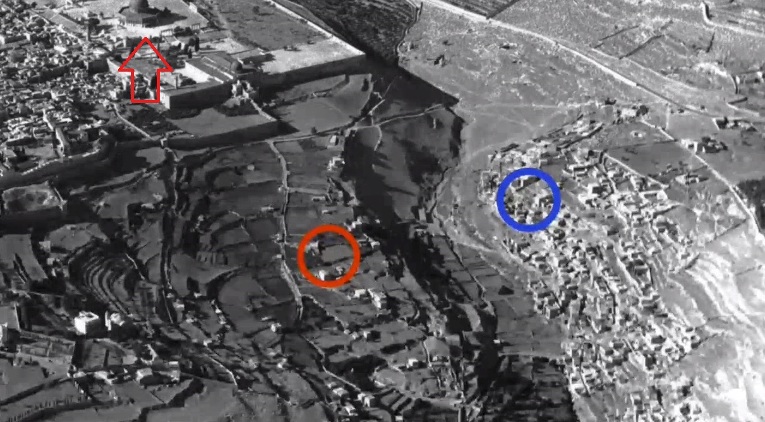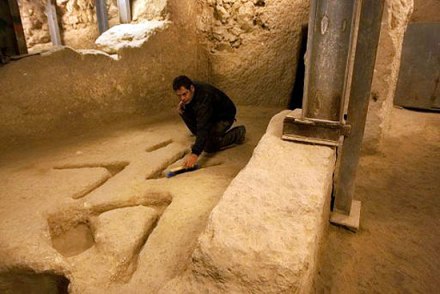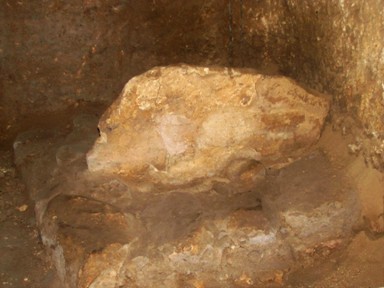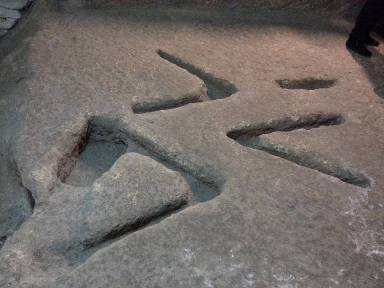
Photo courtesy of Robert Cornuke
(Red circle = Temple?) (Blue circle = Silwan village) (Arrow = Dome of the Rock)
A few weeks ago I wrote about the “Temple Controversy.” In that lesson I attempted to outline the reasons for the “controversy.” Since then I have spent a lot of time studying Scripture and historic documents in an attempt to understand this issue. This, of course, was spurred on by my visit to Israel and the City of David, and by Robert Cornuke’s book Temple.
For centuries it has been assumed that the Temple of God was located on what has become known as the Temple Mount. However, Jesus said that “not one stone would be left on top of another.” (Matthew 24:2) Proponents of the Temple Mount location claim that Jesus was only referring to the buildings when He stated “not one stone will be left on another.” However Eleazar, a Jewish leader, lamented in 73 A.D. to see “the foundations of our holy temple dug up after so profane a manner.” Josephus, The Wars Of The Jews, Book VII, Chapter 8, Paragraph 7.
Today, there is no remaining structural evidence of the Temple of God. It was all leveled. So what basis or documentation can be presented to authenticate the Temple’s location?
For Jews and Christians Scripture tells us, and history confirms, the location of the Temple of God. When reviewing the following information, please remember that Jerusalem (the City of David) at the time of David was the small peninsula-shaped piece of land south of the traditional Temple Mount. It was composed of about twelve acres. It was not the much expanded Jerusalem of today.
“And God sent an angel unto Jerusalem to destroy it: . . . And the angel of the LORD stood by the threshing floor of Ornan the Jebusite. And David lifted up his eyes, and saw the angel of the LORD stand between the earth and the heaven, having a drawn sword in his hand stretched out over Jerusalem.” - First Chronicles 21:15-16
The angel of the Lord was standing over Jerusalem, the City of David. King David bought that property from Ornan for six hundred shekels of gold by weight. (First Chronicles 21:24-26) Later, Solomon built the House of the Lord at the place where David had prepared, in the threshing floor of Ornan the Jebusite. (Second Chronicles 3:1) Solomon built the Temple of God in the Jerusalem of his day, in what we know as the City of David.
Solomon also built the wall around the Jerusalem of his day. (First Kings 9:15) Josephus describes this place as the hill which Solomon encompassed with a wall. (Flavius Josephus, Antiquities of the Jews, Book XV, Chapter 11, Paragraph 3) Josephus continues; “This hill was walled all round, . . . in the midst of which was the Temple itself.” – ibid. Josephus clearly states that the Temple was in the center of this walled compound in the City of David.
Nehemiah chapter three tells of the rebuilding of the walls of Jerusalem after the Babylonian destruction. Verses 15 and 16 specifically mention geographic features (e.g. – the Pool of Siloam) that are only located in the City of David. Nehemiah 12:36-37 confirms that the Jerusalem of the time following the Babylonian Captivity was the City of David.
Scripture and the historian Flavius Josephus tell us that the Temple was in the City of David.
Where is the City of David? David’s men captured the fortified Jebusite stronghold. David lived there and called it the City of David. David filled the areas between the walls and the hill and built upon it. (II Samuel 5:9 )
The area created when the walls were built or expanded around Jerusalem was called the “Millo.” The term comes from the Hebrew word which means “to fill.” When the walls were built, dirt and rubble were used to fill the vacant space and to level the area. This was the millo.
Two hundred years ago, the location of the City of David was not known with certainty. Then Hezekiah’s tunnel was found in 1838. This is the tunnel King Hezekiah had prepared in anticipation of an attack by the Assyrians. (Second Chronicles 32:30) The tunnel runs from the Gihon Spring to the Siloam Pool at the foot of the City of David. Today, archaeologists have found this tunnel beneath the City of David.
“Now after this he (Hezekiah) built a wall without the city of David, on the west side of Gihon, in the valley, even to the entering in at the fish gate, and compassed about Ophel, and raised it (the wall) up a very great height . . .” – Second Chronicles 33:14
Temple worship required “living” water; water that flowed, not from a cistern. Large amounts of water were required for Temple worship. There was much blood, from the many sacrifices, that needed to be washed away. Also, the great bronze Sea, which held 3,000 measures (baths) of water, required almost 18,000 gallons of water to be filled. The priests used this water to cleanse themselves before entering the Temple. This water was changed daily. – The Temple, Alfred Edersheim, p. 45
The root of “Gihon” means to burst forth or gush. The Gihon Spring is a siphon spring, which means that it periodically gushes forth water. Only a very small percentage of all springs are siphon springs.
There is no source of water on or around the traditional Temple Mount. Can you imagine carrying 18,000 gallons of water up to the traditional Temple Mount from the Gihon Spring on a daily basis? This amounts to about seventy-five tons of water daily.
The City of David was located where there was a source of water, the Gihon Spring. Part of the City of David included the Ophel area. The City of David was made defensible with the Kidron Valley on one side and the Tyropean Valley on the other side. The Gihon Spring and Hezekiah’s Tunnel are in the City of David.
We know where the City of David is located. And, again, the Bible and history tell us that the Temple was located in the City of David.
The following is an aerial photograph of the City of David taken in the early 20th Century. The city was leveled, much as it was after its destruction by the Romans in 70 A.D. There were few structures. Also, notice the traditional Temple Mount above the City of David.

If the Temple was located in the City of David, what was the traditional Temple Mount? The Jewish historian Flavius Josephus tells us:
“Now on the north side [of the Temple] was built a citadel, whose walls were square, and strong, and of extraordinary firmness. This citadel was built by the kings of the Hasmonean race, who were also high priests before Herod, and they called it the Tower. “But for the Tower itself, when Herod the king of the Jews had fortified it more firmly than before, in order to secure and guard the temple, he gratified Antonius, who was his friend, and the Roman ruler, and then gave it the name of the Tower of Antonia. “Now as to the Tower of Antonia, . . . it was erected upon a rock of fifty cubits in height, and was on a great precipice; - Flavius Josephus, Wars of the Jews, Book V, Chapter 5, Paragraph 8
The Tower of Antonia was built on a seventy-five foot high precipice. This describes the traditional Temple Mount. It is the only rock precipice in the area. In 73 A.D. Eleazar, a Jewish leader, stated that Jerusalem was totally destroyed except “the camp of those that hath destroyed it, which still dwells upon (over) its ruins.” The Wars Of The Jews, Book VII, Chap. 8, Para. 7.
All that remained was the Roman fort.
Is the traditional Temple Mount actually a Roman fort? Roman forts were all large rectangular structures. They contained barracks for soldiers and administrative buildings. They all were several acres (30-36) in size. This, of course, describes the 36 acre traditional Temple Mount.
Josephus describes the interior of the Tower of Antonia:
“The inward parts had the largeness and form of a palace, it being parted into all kinds of rooms and other conveniences, such as courts, and places for bathing, and broad spaces for camps; insomuch that, by having all conveniences that cities wanted, it might seem to be composed of several cities, but by its magnificence it seemed a palace.” (Flavius Josephus, Wars of the Jews, Book V, Chapter 5, Paragraph 8) This sounds like the traditional Temple Mount.
Josephus describes the Roman fort in Jerusalem as being north of the Temple, and housing a legion of men. (ibid.) A Roman legion had about 6,000 soldiers, plus administrators and support personnel. This could total as many as 10,000 men. 6,000 to 10,000 men would need a fort the size of the traditional Temple Mount.
Dr. Eli Shukron found a coin beneath the lowest course of foundation stones in the Western Wall of the traditional Temple Mount. The coin was dated 17-19 A.D. The Herodian-era Temple walls were completed long before this date. The Western Wall is clearly part of the fortification of the Tower of Antonia.
When the Jews were trying to kill Paul: “And as they went about to kill him, tidings came unto the chief captain of the band, that all Jerusalem was in an uproar. Who immediately took soldiers and centurions, and ran down unto them.” (Acts 21:31-32) Notice that the Roman soldiers ran down to the Temple area.
There are two immovable geographic features at Jerusalem; the Gihon Spring and the rock precipice. These give a strong indication as to the location of the Temple. It just could be that the Temple of God was in the City of David as indicated by Scripture.
Summary:


Photo courtesy of Alan Turner
The Rock Pillar found beneath the City of David.

Photo by author
The small olive press in the special room.
Remember the importance of the Gihon Spring to Temple worship? This special room is located within thirty feet of that spring. It could have been in close proximity of the Temple.
In November 2015 a visitor to the special room found beneath the City of David thought that the strange markings were Paleo-Hebrew letters that said, “Beth El, or House of God.” This was recently confirmed by Dr. William Welty, PhD., a respected figure in the world of ancient Biblical languages.

Dr. Welty, in his opinion, believes the markings say, “Beth El,” or House of God.
This could even be the place where Melchizedek, king of Salem (later known as Jerusalem) and priest of God Most High, met Abram (later renamed Abraham) after Abram rescued Lot. The archaeologists think that this room may be old enough.
This seems to indicate that the special place with the ancient stone pillar, the olive press and Hebrew letters marking it as the House of God is indeed a holy place. I believe this room is a marker.
This special place includes symbols of the “Godhead” or “Trinity.”
This special and holy place is believed to have been carefully filled with layers of dirt and gravel. I believe this was done to preserve it for a generation to come, so that they could find it intact. (Psalm 102:18, Hebrew acharon; hindermost, last) Therefore, the last generation.
This, I believe, is God’s Plan; to have a place created that would be underground to escape the destruction of Jerusalem by both the Babylonians and the Romans, and to be a marker telling us where the House of God was located.
The preservation of this location seems to indicate that this special place with the ancient stone pillar, the olive press and Hebrew letters marking it as the House of God is indeed a holy place. I believe this room is a marker. This special and holy place seems to have been purposefully filled with layers of dirt and gravel. I believe this was done to preserve it for a generation to come. (Psalm 102:18, Hebrew acharon; hindermost, last) Therefore, the last generation.
It is thought the special place was filled with dirt and gravel so that a wall could be built above it without collapsing it. The archaeologists think the wall was of a defensive nature. I wonder if it were not the wall of the Temple of God.
The Most High God, knowing all things as He does, knew of the coming leveling of the City of David. I believe His Plan was to have this room, whether initially above or below ground, preserved underground to escape the destruction and to be a marker of the location of the Temple. This special place, this marker, then could be revealed to the “last generation.” If this is correct, the location of the Temple of God would be known, and the Temple could be built.
“There shall be a place which the LORD your God shall choose to cause his name to dwell there;”–Deuteronomy12:11
I believe this room marks the place the Lord chose in all the world for His name to dwell.
Gemariah the son of Shaphan had a chamber in or at the Temple of God. (Jeremiah 36:10) Archaeological digs directly above the location of the marker room have revealed a clay seal bearing the name “Gemaria son of Shaphan.” This is not confirmation of the location of the Temple, but it is an interesting clue. By the way, the meaning of Gemariah is: “Jehovah has accomplished.” (Strong’s H1587)
I believe this “marker room” will accomplish the Plan of God and, in His timing, reveal the location of the House of God.
It seems clear that the Temple of God was built in the City of David. This marker room, very near the Gihon Spring and bearing the inscription “House of God,” I believe is below the very place where Solomon built the Temple of God.
This offers fascinating possibilities because the Muslims lay no religious claim on the City of David. The Temple could be built without affecting the Dome of the Rock, the al-Aqsa mosque, or Muslim sensibilities.
Bible prophecy indicates that the Temple must exist for the person we Christians call the Anti-Christ to sit in the Temple and declare himself to be God. (Second Thessalonians 2:4) The construction of the Temple is a necessary step toward the glorious Return of the Messiah.
“Even so, come, Lord Jesus.”- Revelation 22:20
Copyright © Ronald Taylor 2016
All international rights reserved
BACK to House of God Page.